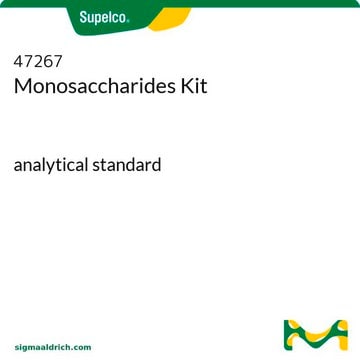推薦產品
等級
analytical standard
品質等級
化驗
≥98% (HPLC)
光學活性
[α]/D 34±1°, c = 10 in H2O
儲存期限
limited shelf life, expiry date on the label
分析物化學類別
oligosaccharides
mp
239 °C (dec.) (lit.)
應用
food and beverages
格式
neat
SMILES 字串
OC[C@@H](O)[C@@H](O[C@@H]1O[C@H](CO)[C@@H](O)[C@H](O)[C@H]1O)[C@H](O)[C@@H](O)C=O
InChI
1S/C12H22O11/c13-1-4(16)7(18)11(5(17)2-14)23-12-10(21)9(20)8(19)6(3-15)22-12/h1,4-12,14-21H,2-3H2/t4-,5+,6+,7+,8+,9-,10+,11+,12-/m0/s1
InChI 密鑰
DKXNBNKWCZZMJT-WELRSGGNSA-N
尋找類似的產品? 前往 產品比較指南
一般說明
Cellobiose is a disaccharide, commonly classified as a reducing sugar. It is mostly produced as an intermediate in the hydrolysis of the polysaccharide cellulose.
應用
D-(+)-Cellobiose may be used as an analytical standard in the following:
D-(+)-Cellobiose may be used as an analytical reference standard for the quantification of the analyte in caramel samples using gas–liquid chromatography coupled to mass spectrometry (GLC–MS).
- Training, testing, and external validation of the gradient retention model developed in ion chromatography using the artificial intelligence-quantitative structure retention relationship (QSRR) model approach.
- Amperometric detection of the analyte in anion-exchange chromatography using copper/cupric oxide nanostructured electrode.
D-(+)-Cellobiose may be used as an analytical reference standard for the quantification of the analyte in caramel samples using gas–liquid chromatography coupled to mass spectrometry (GLC–MS).
儲存類別代碼
11 - Combustible Solids
水污染物質分類(WGK)
WGK 3
閃點(°F)
Not applicable
閃點(°C)
Not applicable
客戶也查看了
Nanostructured cupric oxide electrode: An alternative to amperometric detection of carbohydrates in anion-exchange chromatography
Barragan CTJ and Kubota TL
Analytica Chimica Acta, 906, 89-97 (2016)
Qualitative and quantitative evaluation of mono- and disaccharides in d-fructose, d-glucose and sucrose caramels by gas?liquid chromatography?mass spectrometry: Di-d-fructose dianhydrides as tracers of caramel authenticity
Ratsimba V, et al.
Journal of Chromatography A, 844(1-2), 283-293 (1999)
General, Organic, and Biological Chemistry, 6 (2012)
Development of Gradient Retention Model in Ion Chromatography. Part II: Artificial Intelligence QSRR Approach
Ukic S, et al.
Chromatographia, 77, 997-1007 (2014)
我們的科學家團隊在所有研究領域都有豐富的經驗,包括生命科學、材料科學、化學合成、色譜、分析等.
聯絡技術服務









